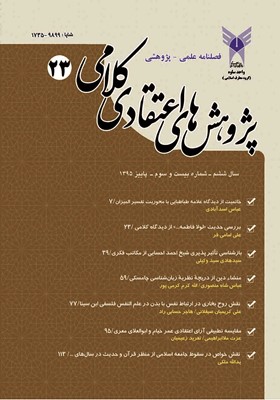منشاء دین از دریچة نظریة زبانشناسی چامسکی
محورهای موضوعی : کلام اسلامیعباس شاه منصوری 1 , الله کرم کرمی پور 2
1 - دانشگاه ادیان و مذاهب قم
2 - دانشگاه ادیان و مذاهب قم
کلید واژه: چامسکی, منشاء دین, منشاء زبان, زبانشناسی,
چکیده مقاله :
از مسائل مهمی که در مطالعات دینپژوهی مورد توجه اندیشمندان این عرصه قرار میگیرد، مبحث مهم «منشاء دین» میباشد. از این زاویه گروهی قائل به منشاء الهی و گروهی نیز منشاء انسانی برای آن قائلند. در این میان یکی از مباحثی که میتواند در حکم مویدی بر هر کدام از این دو دیدگاه باشد، مساله زبان و منشاء آن است. بر این اساس در این مقال با پرداختن به دیدگاه زبان شناس معروف معاصر نوآم چامسکی به موضوع منشاء زبان در می یابیم که در این دیدگاه، زبان منشایی فطری داشته و این توانایی به غیر از آموزش و اکتساب برای انسان حاصل میآید و بدین طریق با اثبات غیر انسانی بودن حداقل یکی از پارامترهای حیات انسانی به نام «زبان» میتوان خط بطلانی کشید بر دیدگاه کسانی که در منشاء دین توجیهی طبیعی نموده و امری انسانی برای آن قائلند. و بدین طریق میتوان از غیر انسانی بودن منشاء زبان، به غیر انسانی بودن منشاء دین نیز گریز زد و از این اثبات، نفی انسانی بودن منشاء دین را قائل شد.
The important issues in the field of religious studies scholars are concerned, the important topic "The origin of religion" is. In this context the group believes in the divine origin and human origin groups also attach to it. In the meantime, one of the issues that can be evidence of sentence on each of the two views, it is the language problem and its origin. On the basis of these articles addressing contemporary linguist Noam Chomsky comments to the subject of the origin of language, we find that through the proof of the inhumanity of at least one of the parameters of human life in the name of "language" can put an end to the views of those in the natural origin of religion and humane justification for the distinction And thus can be of non-human origin, language, religion escape the inhumanity of his origin and proof of the origin of human negation of religion were allowed
۱. دبیر مقدم، محمد، (1386)، زبانشناسی نظری (پیدایش و تکوین دستور زایشی)، ویراست دوم، تهران: سازمان مطالعه و تدوین کتب علوم انسانی دانشگاهها (سمت)، چاپ دوم.
۲. زاهدی، کیوان، (1385)، زبان شناسی چامسکی، پژوهشنامه علوم انسانی، شماره 50، تابستان1385، (13-36)
۳. قائمی نیا، علیرضا، (1379)، درآمدی بر منشأ دین، قم: انتشارات معارف.
۴. مشکوه الدینی، مهدی، (1376)، سیر زبانشناسی، مشهد: دانشگاه فردوسی مشهد، چاپ پنجم.
۵. یول، جورج، (1386)، نگاهی به زبان (یک بررسی زبان شناختی)، ترجمه نسرین حیدری، تهران: سازمان مطالعه و تدوین کتب علوم انسانی دانشگاه¬ها (سمت)
6. Chomsky, Noam, (1964), Current Issues in Linguistic Theory, The Hague: Mouton.)
7. _____________, (1965), Aspects of the Theory of Syntax, Cambridge, Mass.: MIT Press.
8. _____________, (1966), Cartesian Linguistics, New York: Harper and Row.)
9. _____________, (1972), Language and mind, Enlarged Edition. Harcourt Brace Jovanovich, Inc.
10. _____________, (1975), The Logical Structure of Linguistic Theory, New York: Plenum.
11. _____________, (1986a), Knowledge of Language: its Nature, origin, and Use, New York: Praeger.
12. _____________, (1986b), Barriers, Cambridge: Mass.:MIT Press.
13. _____________, (2000a). New Horizons in the Study of Language and Mind. Cambridge: CUP.
14. _____________, (2002). On Nature and Mind. Cambridge: CUP.
15. _____________, (1965). Aspects of the Theory of Syntax. Cambridge, MA: MIT Press.
16. _____________,(1980). Rules and Representations. Oxford: Basil Blackwell.
17.Humboldt, Wilhelm von. (1836/1988). “Uber die Verschiedenheit des Menschlichen Sprachbaues”. Berlin. Translated by Peter Heath as The Diversity of Human Language- Structure and its Influence on the Mental Development of Mankind. Cambridge:CUP.
18. Lyons, John, (1984), Language and Linguistics, An Introduction, Cambridge University Press.)
19. Newmeyer, f, (1980), Linguistic Theory in America, New York: Academic Press.
20. __________, (1986), Has There Been a “Chomskyan Revolution” in Linguistics? Language, 62: 1-18.)

